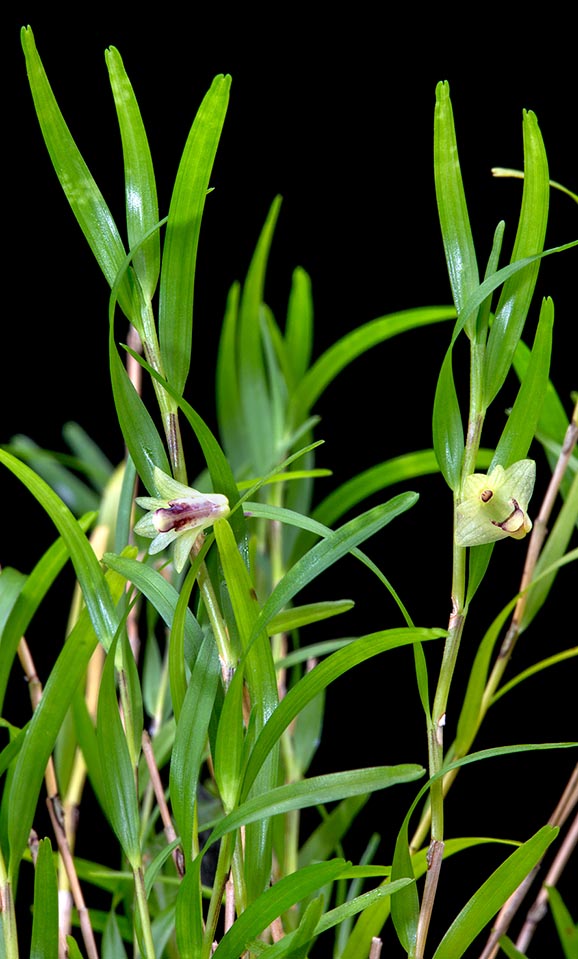Family : Orchidaceae

Text © Pietro Puccio

English translation by Mario Beltramini

Rare in cultivation, Dendrobium poneroides is a New Guinea epiphyte with flattened thin stems and unusual alternate bilobed leaves at the apex. Isolated flowers with about 1 cm of diameter © Giuseppe Mazza
The name of the genus is the combination of the Greek substantives “δένδρον” (dendron) = tree and “βίος” (bios) = life, with reference to the numerous species of the genus living on the trees; the specific name is the combination of the name of the genus Ponera Lindl. (1831) and of the Greek suffix “-οειδής” (-oeidés), from “εἶδος“ (êidos) = shape, look, hence resembling.
The Dendrobium poneroides Schltr. (1911) is an epiphytic species with thin stems, flattened, 10-20 cm long, provided over all their length of alternate leaves, linear with bilobate apex, 2-2,5 cm long and 2-2,5 mm broad.
Inflorescences from the nodes along the stem bearing one single flower, on a pedicel and ovary 2-3 mm long, of about 1 cm of diameter, with pale greenish yellow sepals and petals and dark red labellum with greenish apex. Ovate dorsal sepal with obtuse apex, 4-5 mm long and 2,5 mm broad, ovate-triangular lateral sepals with obtuse apex, 5 mm long and broad, united at the base to form a sort of a spur (mentum) with an about 5 mm long obtuse apex.
Lanceolate petals with obtuse apex, 4 mm long and 1,5 mm broad, trilobate labellum, about 7 mm long and 4 mm broad, with erect lateral lobes on the sides of the column, obtuse, and ovate median lobe with obtuse apex, about 3 mm long and broad, and about 2 mm long column.
Miniature orchid rare in cultivation, present almost exclusively in specialized collections, requires the typical conditions of an intermediate semi-shaded greenhouse, aerated, with high and constant humidity, 75-85%.
Regular waterings so to maintain permanently humid, but without stagnations, the substratum, utilizing rain water, by reverse osmosis or demineralized. It can be cultivated in pots or baskets, with a draining and aerated compost based on bark fragments, or mounted on small logs, pieces of bark or rafts of cork or of roots of arborescent ferns covered by sphagnum. Repottings and possible divisions are to be done at the vegetative restart signalled by the emission of the new roots.
The species is reported in the appendix II of the CITES (species whose trade is internationally ruled).
Synonyms: Monanthos poneroides (Schltr.) Brieger (1981).
→ For general notions about ORCHIDACEAE please click here.
